

NPR Cookie Consent and Choices. Untitled. Japanese firm falsified data on earthquake protection equipment. A Japanese hydraulics firm has admitted falsifying inspection data for equipment used to protect hundreds of buildings from major earthquakes, including venues for the 2020 Tokyo Olympics.

Tokyo-based KYB and a subsidiary said the practice of doctoring data for hydraulic oil dampers – which control vibration and reduce shaking during earthquakes – affected almost 1,000 structures across Japan. But the firm said the data problem – the latest in a string of quality-control scandals to hit Japanese companies – did not present an immediate safety risk. The land ministry also attempted to allay safety concerns, saying the affected buildings would be able to withstand a quake measuring a maximum 7 on the Japanese seismic intensity scale. Quakes of that intensity cause buildings to sway with such force that people find it impossible to stay on their feet and risk being “thrown through the air”. KYB is the latest Japanese firm to admit that it cut corners when compiling data.
Six years on, Fukushima child evacuees face menace of school bullies. TOKYO (Reuters) - "Radiation!
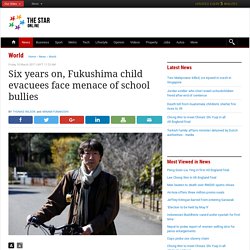
Bang bang! " Gesturing as if with guns, two boys in Tokyo repeatedly taunted a girl whose family fled to Japan's capital to escape radioactivity unleashed by the Fukushima nuclear crisis of 2011. Hiroshima, 70 Years Later: Why the United States Bombed the Japanese City. On May 10, 1945, three days after Germany had surrendered to the Allied powers and ended World War II in Europe, a carefully selected group of scientists and military personnel met in an office in Los Alamos, New Mexico.
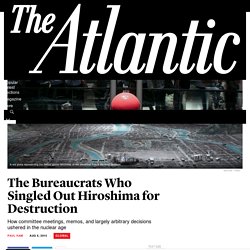
Japan Airlines Flight 123 - Wikipedia. Japan Airlines Flight 123 (日本航空123便, Nihonkōkū 123 Bin?)
Lived in Japan for 7 years, and during that time this happened. The nation mourned, and I cried with them. – clarelucy
Was a scheduled domestic Japan Airlines passenger flight from Tokyo's Haneda Airport to Osaka International Airport, Japan.
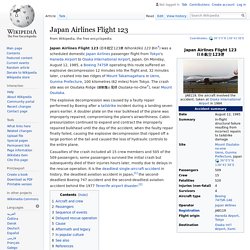
On Monday, August 12, 1985, a Boeing 747SR operating this route suffered an explosive decompression 12 minutes into the flight and, 32 minutes later, crashed into two ridges of Mount Takamagahara in Ueno, Gunma Prefecture, 100 kilometres (62 miles) from Tokyo. The crash site was on Osutaka Ridge (御巣鷹の尾根, Osutaka-no-One?) , near Mount Osutaka. 【台風第21号】ツイッター動画まとめ 2018/09/04【被害甚大】 -Typhoon Jebi hit Osaka Western Japan- Three more Vietnamese trainees duped into cleaning up Japan’s nuclear disaster zone: report - VnExpress International.
Japanese authorities are looking into a case in which they believe that three Vietnamese trainees may have been tricked into working in areas affected by the Fukushima nuclear disaster that took place in 2011.
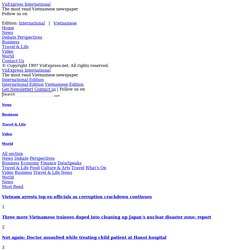
The Fukushima Exclusion Zone Was Swallowed By Nature. Polish photographer Arkadiusz Podniesinski travelled to the site of the Fukushima nuclear disaster last month to see the location with his own eyes.
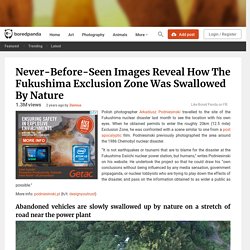
When he obtained permits to enter the roughly 20km (12.5 mile) Exclusion Zone, he was confronted with a scene similar to one from a post apocalyptic film. Japan Radiation Map. Japan's post-tsunami recovery plan: tomatoes, fish and hula-dancing. It’s a cold January day in Iwaki City, 211km north of Tokyo.

But here, in a balmy glasshouse, light and sunny, pop music is being piped in, and tonnes of tomatoes are ripening and being picked. They’re not in the ground; they’re being grown from waist-high pots of coconut matting. These are no ordinary tomatoes. They are growing on Wonder Farm, an “integrated agricultural theme park”, run by Tomato Land Iwaki, which is part-funded by the local city council and the Fukushima prefecture. After the tsunami: Japan's sea walls – in pictures. Six Years After Fukushima, Robots Finally Find Reactors’ Melted Uranium Fuel. A Tepco guide explained this was because the central plant grounds had been deforested and paved over, sealing in contaminated soil.

During a recent visit, the mood within the plant was noticeably more relaxed, though movements were still tightly controlled and everyone was required to wear radiation-measuring badges. Inside a “resting building,” workers ate in a large cafeteria and bought snacks in a convenience store. Japan Earthquake. Japan mapping (Rad/Quake) 5 Years Since Great Japan Earthquake click 2x.
Japan Pictures Likely Show Melted Fukushima Fuel for First Time - Bloomberg. New images show what is likely to be melted nuclear fuel hanging from inside one of Japan’s wrecked Fukushima reactors, a potential milestone in the cleanup of one of the worst atomic disasters in history.

Tokyo Electric Power Co. Holdings Inc., Japan’s biggest utility, released images on Friday showing a hardened black, grey and orange substance that dripped from the bottom of the No. 3 reactor pressure vessel at Fukushima, which is likely to contain melted fuel, according to Takahiro Kimoto, an official at the company. The company sent a Toshiba-designed robot, which can swim and resembles a submarine, to explore the inside of the reactor for the first time on July 19. “Never before have we taken such clear pictures of what could be melted fuel,” Kimoto said at a press briefing that began at 9 p.m. Friday in Tokyo, noting that it would take time to analyze and confirm whether it is actually fuel. Early Signs Removal Plans.
Fukushima disaster: Radiation levels posing cancer risks on fourth anniversary of earthquake. By North Asia correspondent Matthew Carney Updated Four years ago today Japan was hit with a magnitude 9.0 earthquake and massive tsunami that caused widespread destruction, leaving almost 22,000 people dead or missing and triggering a crisis at the Fukushima Daiichi nuclear plant.
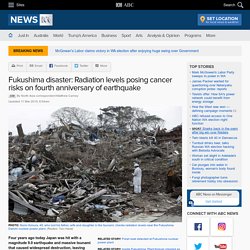
The triple nuclear meltdown was the world's worst nuclear disaster since Chernobyl. About 120,000 people still cannot return their homes because of high radiation levels, but the issue of long-term health implications like cancer are causing the greatest concern and controversy in Japan. The displaced visit former lives - 2 clicks. A woman poses inside a laundromat destroyed by the Fukushima Daiichi nuclear disaster.Carlos Ayesta & Guillaume Bression In March 2011, the biggest nuclear disaster since Chernobyl occurred in the Tōhoku region of Japan. The Fukushima Daiichi nuclear disaster was caused by an earthquake and then a resulting tsunami. The devastating string of evens caused thousands of deaths. Three major hydrogen explosions occurred on site over the course of three days.
Then now photos disaster Japan - 2 clicks. We can't see inside Fukushima Daiichi because all our robots keep dying - ExtremeTech. Tepco, the utility company tasked with overseeing cleanup and waste processing for the former Fukushima Daiichi nuclear plant, hit another snag this week. Last month, we reported on new findings about Reactor #2 that showed it was far more radioactive inside than previously measured. At the time, we noted that Tepco was working on a new robot that could handle up to 73 sieverts of radiation, but the measured level of 530 sieverts vastly exceeded that tolerance. Now, Tepco has admitted that repeated robot failure is hampering its plan to search the bottom of the reactor, and find the estimated 600 tons of fuel and debris that may have poured out of the reactor and into the concrete lining below it.
Initial attempts to see into Reactor #2 via robotic probe have all failed. Japan’s $320 Million Gamble at Fukushima: An Underground Ice Wall. FUKUSHIMA DAIICHI NUCLEAR POWER STATION — The part above ground doesn’t look like much, a few silver pipes running in a straight line, dwarfed by the far more massive, scarred reactor buildings nearby. More impressive is what is taking shape unseen beneath: an underground wall of frozen dirt 100 feet deep and nearly a mile in length, intended to solve a runaway water crisis threatening the devastated Fukushima Daiichi Nuclear Power Station in .
Officially named the Land-Side Impermeable Wall, but better known simply as the ice wall, the project sounds like a fanciful idea from science fiction or a James Bond film. But it is about to become a reality in an ambitious, and controversial, bid to halt an unrelenting flood of groundwater into the damaged reactor buildings since the disaster five years ago when an earthquake and a tsunami caused a triple meltdown. However, the ice wall has also been widely criticized as an expensive and overly complex solution that may not even work.
Photo. Japan Earthquake & Tsunami of 2011: Facts and Information. On March 11, 2011, a magnitude-9 earthquake shook northeastern Japan, unleashing a savage tsunami. The effects of the great earthquake were felt around the world, from Norway's fjords to Antarctica's ice sheet. Tsunami debris continues to wash up on North American beaches two years later. In Japan, residents are still recovering from the disaster. Radioactive water was recently discovered leaking from the Fukushima Daiichi Nuclear Power Plant, which suffered a level 7 nuclear meltdown after the tsunami. Japan relies on nuclear power, and many of the country's nuclear reactors remain closed because of stricter seismic safety standards since the earthquake. The total damages from the earthquake and tsunami are estimated at $300 billion dollars (about 25 trillion yen), according to the Japanese government.
Fukushima: Five years after nuclear disaster. PHOTOS: Rescuers Search For Survivors After Powerful Quakes Hit Southern Japan. A short History of Earthquakes in Japan. The Great Japan Earthquake of 1923 2 clicks. Earthquake on Kyushu island, Japan – in pictures.